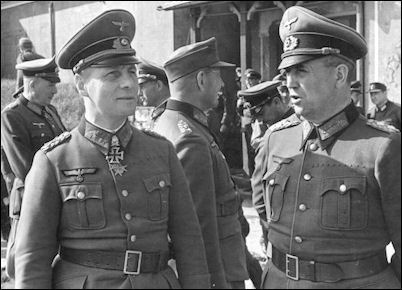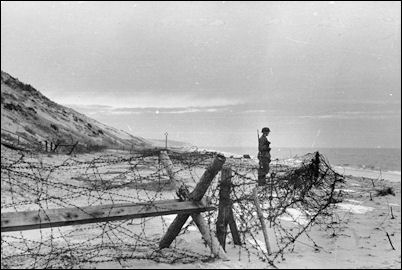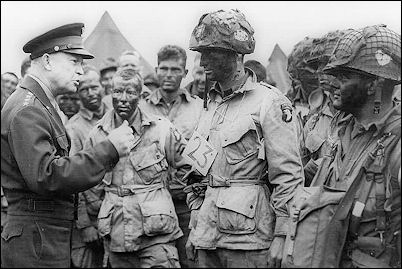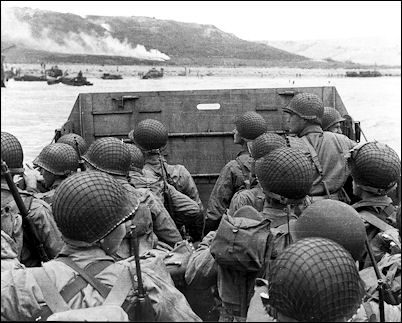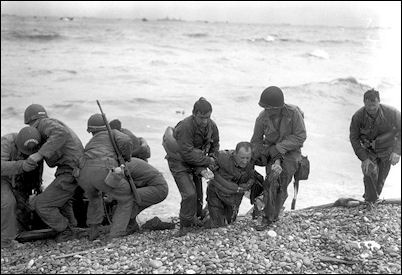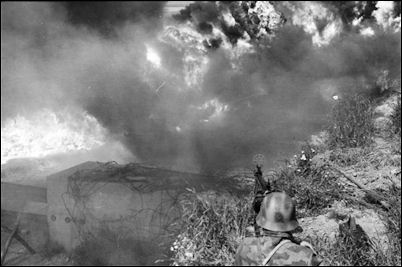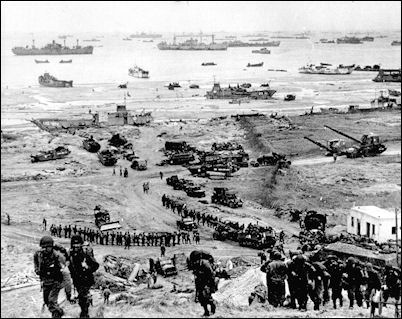![]()

D-Day Invasion
Since early 1942, Soviet leader Josef Stalin had been urging a major new front in Western Europe to take some of the pressure off his troops, complaining that his soldiers were carrying too much of the burden. Thus far in the war, eighty percent of German military casualties had occurred at the hands of Russian soldiers. All the while, Stalin had grown increasingly impatient with his Allies.
The opportunity to talk things out came in November 1943, when the Big Three – Roosevelt, Churchill and Stalin – met for their first face-to-face meeting at Teheran in the Middle East. During the conference, Roosevelt consented to Stalin's request to set a specific date for the American-led invasion of Western Europe.
Churchill was not as keen on the idea, which involved a dangerous hundred-mile crossing of the English Channel into northern France. The British had already tried an amphibious assault on their own, targeting the French port of Dieppe in August 1942, with disastrous results. Churchill therefore maintained the quickest way to defeat Nazi Germany was through the Italian Front into southern Europe. However, he was overruled by Roosevelt and Stalin, and a preliminary date of May 1944 was set for the seaborne invasion of northern France.
Germans along the coast of France were already aware of the huge buildup of American troops, ships and equipment in southern England. They knew a crossing was coming at some point – the only question was where and when. As a defensive measure, they had begun building the Atlantic Wall, an elaborate system of heavy cement fortifications that would span the entire coastline opposite England. But as the spring of 1944 approached and the invasion appeared imminent, it was only about half finished. To make up for the shortfall, the Germans planted a million mines, laid mile upon mile of barbed-wire, and installed thousands of jagged underwater obstructions designed to rip holes in the hulls of landing craft.
To stave off the invasion, Hitler chose Field Marshal Erwin Rommel, the brazen veteran of the North Africa campaign. Rommel's plan was to have German infantrymen and tanks confront the Allies on the beaches and kick them back into the sea, to prevent the landing troops from gaining even a toehold in the sand.
Rommel and members of the High Command, including his superior, Field Marshal Gerd von Rundstedt, Commander of Army West, thought the Allies would probably land at Calais, the narrowest distance between southern England and the coast of France. Their assumption was confirmed by the heavy buildup of Allied troops in the seaports directly opposite Calais. In truth, these were phony maneuvers cleverly combined with false intelligence leaked by the Allies to convince the Germans they had guessed correctly. Rommel and Rundstedt therefore positioned the bulk of their troops, fifteen infantry divisions, around Calais, while a smaller number was stationed about 200 miles to the west near the Normandy beaches, considered a less likely landing spot.
The Germans had also determined the invasion would likely come during May amid the favorable spring tides. And so they stood by on high alert. But despite weeks of calm weather and good tides, May was unexpectedly quiet. As June began, a powerful storm moved in bringing high winds, rain and heavy seas to the English Channel. Confident the rough seas and heavy cloud cover had postponed any invasion plans for a while, Rommel drove off to visit his family at their home in southern Germany. Additionally, most of Rommel's command staff headed inland to a military conference. At the same time, the stormy weather brought a temporary halt to all German aerial and seaborne reconnaissance around the English Channel.
Across the Channel, at his headquarters, Allied Supreme Commander, General Dwight D. Eisenhower, faced a momentous decision. Everything was now in place for Operation Overlord and the chosen invasion day, Monday, June 5th. But the seas were far too choppy. The American, British and Canadian landing troops might wind up at the bottom of the Channel, or land on the beaches too wobbly from sea sickness if they survived the crossing. On the other hand, if the invasion was postponed by more than a day or two, and the entire force was to stand down, the next workable date would be perhaps mid-July, or even later, due to the immense amount of logistical coordination involved.
General Eisenhower needed a break in the weather. Checking and rechecking the weather maps, his chief meteorologist saw a window of opportunity emerging for Tuesday morning, June 6th, although conditions would still not be ideal. After receiving this update, and upon consulting with his landing troop commanders, Field Marshal Bernard Montgomery and General Omar Bradley, Eisenhower came to his decision. "OK, We'll go," he said.
Two things then happened. In the predawn hours of June 6th, American paratroopers of the 82nd and 101st Airborne Divisions along with the British 6th Division parachuted into Normandy, attacking rear positions of the German 7th Army, while British glider troops seized key bridges. Additionally, BBC radio broadcasts included short declarative sentences which were special coded messages to the French Underground, spurring them to sabotage German communications throughout France.
By dawn of D-Day, the greatest seaborne invasion force ever assembled was slowly approaching the Normandy Coast, taking the German soldiers there by surprise. Four thousand vessels carried the troops while over 2,000 American and British warships furiously bombarded the landing zones, five beaches stretching along a sixty-mile front. The British 2nd Army landed toward the east at beaches code-named Gold, Juno and Sword. The American 1st Army landed toward the west at beaches named Utah and Omaha.
At Omaha Beach, the Americans got the worst of it. A soldier of the 116th Infantry Division recalled: "I got out in water up to the top of my boots. People were yelling, screaming, dying, running on the beach, equipment was flying everywhere, men were bleeding to death, crawling, lying everywhere, firing coming from all directions. We dropped down behind anything that was the size of a golf ball. Colonel Canham, Lieutenant Cooper, and Sergeant Crawford were screaming at us to get off the beach. I turned to say to Gino Ferrari, 'Let's move up, Gino,' but before I could finish the sentence, something spattered all over the side of my face. He'd been hit in the face and his brains splattered all over my face and my stuff. I moved forward and the tide came on so fast it covered him and I no longer could see him."
For German field commanders on the scene, the first minutes of the invasion brought great alarm and great confusion. Frantic phone calls went out to their generals and they in turn phoned the High Command, whose ranking members were presently staying with Hitler at his mountaintop villa at Berchtesgaden, not at their regular headquarters.
The immediate question was whether or not the Normandy landings, and earlier attacks by parachutists, were all part of an elaborate Allied ruse to draw their attention away from Calais. No one could say for sure. The result was indecision by Hitler and the High Command. And this bought precious time for the Allied landing troops now inching themselves forward in the sand.
In marked contrast to the rigid and inflexible command structure Hitler had imposed on his armies, Allied field commanders were authorized by General Eisenhower to make on-the-spot decisions about how to proceed. For the Americans at both Utah and Omaha beaches, this frontline improvisation saved the day. At Utah, troops under the command of General Theodore Roosevelt Jr. quickly realized they had landed on the wrong spot, a sparsely defended stretch of beach with a single road leading inland. Roosevelt decided to press forward anyway, gambling that he could get his troops off the beach and dash inland via the small road before the Germans could reposition themselves for a counter-attack. And it worked.
At Omaha, American troops were pinned down amid withering cross fire from Germans perched along high cliffs located at either end of the beach. Responding to calls for help, U.S. Naval commanders sailed their destroyers dangerously close to the beach and blasted the entrenched Germans at nearly point-blank range even though they risked getting blown out of the water by the big German artillery guns that were still functioning. American soldiers on the beach then climbed the cliffs and dislodged the Germans one-by-one, taking out the machine-gun nests and 88mm guns which had so far killed hundreds of Americans.
At Gold, Juno and Sword beaches, British and Canadian troops under Montgomery met less initial resistance and moved a mile or so inland. Meanwhile, German field commanders on the scene waited for authorization to utilize their reserves and counter-attack.
Field Marshal Rommel, the man who was supposed to command the entire coastal defense, was completely out of touch at the moment, rushing back by car from his home, in a 400-mile journey that would take hours. Flying was out of the question due to the risk posed by Allied fighters which now enjoyed total air supremacy.
As the hours passed and Calais remained completely quiet, German field commanders phoned the High Command for permission to rush all available reinforcements including two nearby Panzer divisions to Normandy. But Hitler said he wanted to wait until the overall situation became clearer. In the meantime, British and Canadian troops continued to advance inland while the Americans broke free of Omaha and moved inland as well.
Late in the afternoon, with Calais still quiet, Hitler finally gave the go-ahead, along with an order stating the entire Normandy beachhead “must be cleaned up by not later than tonight.”
Rommel now arrived at his command post and began digesting a multitude of situation reports. He relayed the Führer's order to 7th Army headquarters to clean up the whole beachhead, only to be told, "That would be impossible."
By nightfall, over 150,000 Americans, British and Canadians had come ashore against all odds, amid 9,000 casualties. Within a week, a half-million men had landed and the five landing beaches were linked together as a unified front. With the beachhead secured, two floating seaports were assembled off shore to import a gigantic arsenal of American-made weaponry including thousands of Sherman tanks that would be used to build armored divisions ready to sweep inland.
For the Germans around Normandy, reinforcements belatedly arriving from Calais and elsewhere were mercilessly blasted by long-range Naval guns and ripped to shreds by American and British fighter and bomber planes.
In the days that followed, given all they were up against, Field Marshals Rundstedt and Rommel decided the time had come to have a talk with their Supreme Commander about the possibility of saving their troops, and Germany itself, from all but certain destruction.
The two Field Marshals met with Hitler on Saturday, June 17, 1944, hoping to talk some sense into him. At first Rommel asked to have a free hand to pull back his troops from the Normandy coast so they could regroup for an inland counter-offensive, out of range of the Allied warships. Hitler said no, and tried to soothe Rommel with promises of newly developed super weapons including jet-powered planes that would sweep the Allies from the sky and self-propelled flying (V-1) bombs that would spell the demise of Britain.
Rommel responded with a blunt assessment of the war, declaring that American and British superiority in the air, at sea and on land meant they would soon break through to Germany itself, while at the same time, the Russian Front simply could not be held. Therefore, Rommel informed Hitler, the time had come to consider bringing the war to an end. But this was too much for the Führer and he scolded his Field Marshal like a schoolboy, "Don't you worry about the future course of the war, but rather about your own invasion front."
The two Field Marshals had a second meeting with Hitler, on June 29th, with similar results. After this, Rundstedt lost his patience – and his post as Commander of Army West. This occurred when Rundstedt insulted Hitler's chief military aide, Field Marshal Wilhelm Keitel, who had asked during a phone conversation – what should be done in response to the ongoing Allied success? "Make peace, you fools. What else can you do?" Rundstedt had shot back.
Rommel, for his part, tried to convince Hitler once more, this time by sending him a letter which praised the heroism of the German fighting troops, but also advised "the unequal struggle is nearing its end."
By late June, American troops under General Bradley had liberated Cherbourg at the tip of the Normandy peninsula, while taking 25,000 German prisoners. This was followed by hard fighting during the Battle of the Hedgerows throughout July in which American tanks pierced the German southward defenses and broke free of the peninsula entirely. Meanwhile, British and Canadians under Montgomery overcame stiff opposition to capture the city of Caen to the east, following an astounding air raid by two thousand bombers. Soon after, the Americans reached Avranches, south of Normandy, then circled eastward to meet up with Montgomery at Falaise, trapping the remnants of the German 7th Army inside a narrow pocket, resulting in 50,000 more prisoners.
Soon the roads to Paris and to the east, including Germany, would be opened by the Americans and British-Canadians.
Through it all, Hitler had stubbornly maintained he would crush the Allied invasion force in due time. All indications to the contrary were ignored, while Hitler made it very clear the war would continue indefinitely, regardless of the consequences.
But by now, more of his senior officers had become gravely concerned about Germany's prospects in the war. The time had come, so it seemed, to stop the madness one way or another. Germany simply could not fight the whole world.
Copyright © 2010 The History Place™ All Rights Reserved
![]()
NEXT SECTION - Running Out of Time
The Defeat of Hitler Index
The History Place Main Index Page
Terms of use: Private home/school non-commercial, non-Internet re-usage only is allowed of any text, graphics, photos, audio clips, other electronic files or materials from The History Place.
